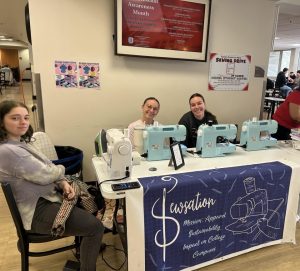Neighborhood group to make Main ‘walkable’
As students go about their daily routines, Peoria resident Lisa Ferolo and the proponents of the Walkable West Bluff campaign are working to make the Main Street area more pedestrian-friendly for students and residents.
Ferolo said members of the organization, founded by a group of neighbors and concerned citizens, are looking to make this section of the city “more vibrant, more walkable and make business more accessible.”
Walkable West Bluff hopes to be able to work with Bradley on a survey of the ways students and residents spend their money, and to present its findings as a selling point for new businesses, Ferolo said. The organization is also gathering information on the wants and needs of the community to properly distinguish what types of businesses to approach as possibilities.
Another goal of the organization is to display student art, elementary through university level, in vacant business windows in the Main Street area, Ferolo said. Having already had a strong response from a student display in the Lagron Miller storefront, she said Walkable West Bluff will look to bring more of the same to Main Street businesses, grabbing the attention of all who pass and reminding them the community is “alive and kicking.”
Senior English major Sarah Heimsoth said she hopes to see the Main Street area become a place with more of an identity.
“I’d like to see a mixture of some affordable chain restaurants for students, but I also think it’s important to have places that are unique to the Bradley area alone,” she said. “I think students would really like to have that favorite place that can only be found at their college.”
Heimsoth said she thinks most students are not interested in many of the current businesses on Main Street and walking to most of them is not usually a safe option.
Sophomore dietetics major Merry Caemmerer said she agrees.
“I think I can speak for myself and other students by saying that the perception of Main Street is probably not the best,” she said. “If it was more brightly lit and felt safer in general, I think walking would become a more acceptable idea for most students. That would probably help businesses a lot as well.”
Ferolo said she wishes to see some drastic changes on Main Street.
“Personally, I am hoping to see a complete change of infrastructure in order to make it look like a pedestrian street,” she said. “This would include sidewalks, medians and crosswalks. This needs to be a street shouting that this is a pedestrian friendly area.”
In addition, Ferolo said enabling area residents to walk instead of drive would benefit the environment and lessen the community’s reliance on gas. She said giving Main Street a facelift and building business in the area would greatly increase the economics of the community and make life more enjoyable and convenient for its residents.
Traffic study suggests lane reductions on Main
The Peoria Public Works Department supports reducing the number of lanes on Main Street from Bourland Avenue to downtown.
In addition to reducing lanes east of Main, the center turn lane, which is currently on Main from University Street to Farmington Road would be removed under a plan the public works department plans to present to the Peoria City Council by the beginning of November.
The plan was presented to an audience of about 40 people at a public hearing on Monday.
The $52,000 traffic study used to create the recommendation was started in February of last year and focused on both arterial streets and side streets such as Moss Avenue and Colombia Terrace.
Public Works Director David Barber said the city’s goal is to make Main more pedestrian-friendly while keeping traffic out of the neighborhoods surrounding it.
Public works came up with the suggestion after studying four different options with varying traffic patterns, for instance making Martin Luther King Boulevard a two-way street.
The recommendation includes restricting left turns along Main. The only street a left-hand turn could be made on would be Maplewood Avenue, where the new Main West parking deck is located. This would mean the only entry and exit points to Bradley from University and Main streets would be at the University and Saint James Street entrance and the Main and Maplewood entrance.
Barber said the study did not include University or the section of Main right in front of One World because reducing any lanes there would cause too much congestion and overflow into neighborhoods.
Crowd reactions to the study were not always favorable. Many residents felt the study lacked validity, and would not result in a more pedestrian-friendly area. One resident said if the goal of the city is to make the area pedestrian-friendly, then traffic shouldn’t be an issue.
Barber said traffic does need to be a main concern in any plans to alter the Main corridor because reducing lanes on Main or University could funnel traffic elsewhere.
“If we eliminate one or two more lanes, we’ll have traffic backed up significantly,” he said. “What we don’t want to do is put more traffic into your neighborhoods.”
Barber also said he and his staff, along with 2nd District Councilwomen Barbara Van Auken, would review suggestions from the forum before making a recommendation to the city council.
Van Auken said after the recommendation is made, money will have to be found in the city’s budget for next year to fund a second study.
Barber said a second study could cost about $75,000, and if the city does end up altering the Main Street corridor, it could cost millions of dollars.




